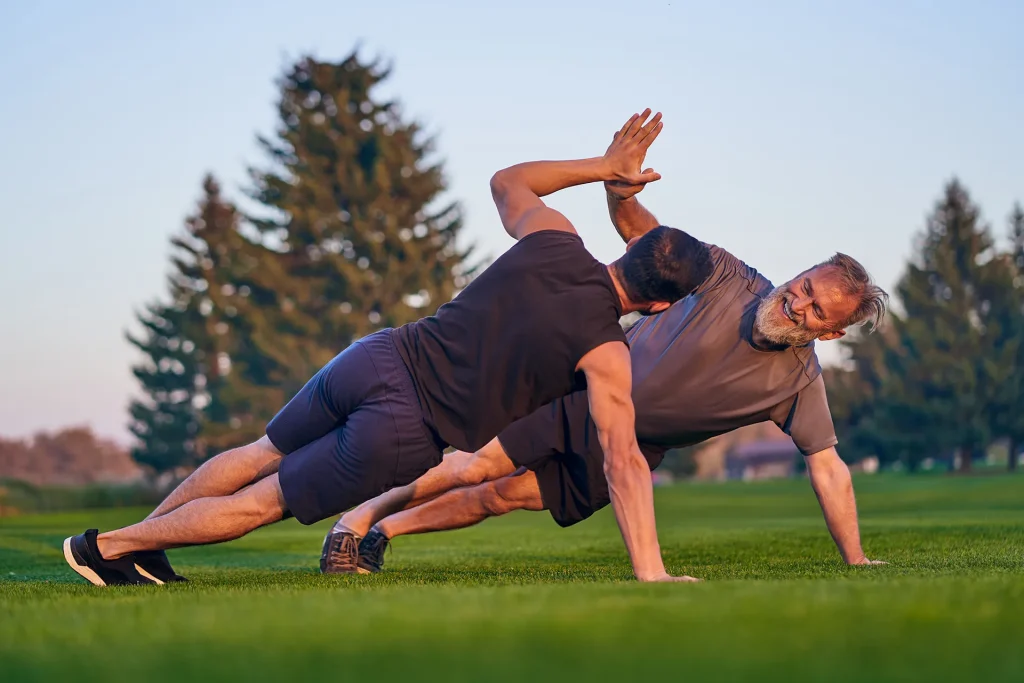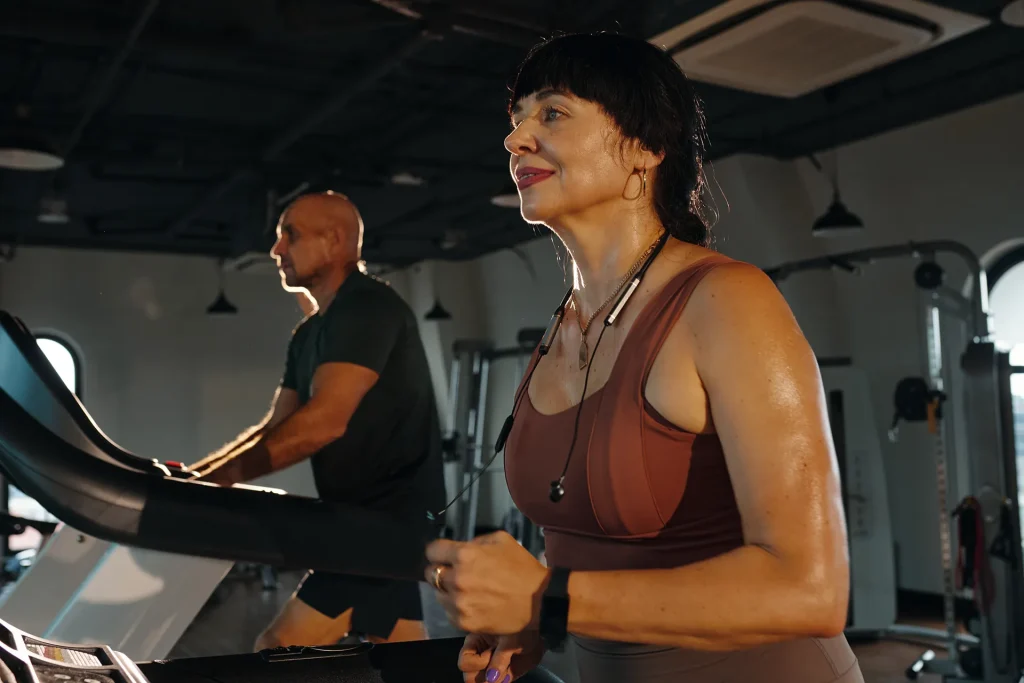TRAINING
HIIT Without The Hurt – Adapting Interval Training For Older Adults

As fitness instructors, we’re always looking for ways to help our participants achieve optimal health and fitness, regardless of their age. High-Intensity Interval Training (HIIT) continues to gain in popularity due to its efficiency and effectiveness. But when it comes to older adults, many instructors hesitate to incorporate HIIT into their routines, fearing it might be too intense or risky. However, research shows that HIIT can be not only safe but highly beneficial for older adults when properly adapted.
Understanding the benefits of HIIT for older adults
Before diving into the strategies, it’s good to understand why we’re doing it! Studies have shown that group HIIT classes can lead to significant improvements in various aspects of health and fitness for older adults. These include:
- Enhanced cardiovascular health and aerobic fitness
- Improved cognitive function and potential neuroprotective effects
- Increased muscle strength and mass, particularly in lower body
- Better metabolic function and reduced abdominal fat
- Improved balance, mobility, and functional fitness
- Enhanced overall quality of life.
These benefits are particularly important as we age, helping our participants to maintain their independence and general wellbeing. HIIT’s time efficiency compared to traditional moderate-intensity training also makes it ideal for group classes. It allows instructors to pack additional fitness components – like balance work or floor exercises – into a single session, benefiting older adults who may have limited time or energy for exercise.

Designing safe HIIT programs for older adults
Whether you are running standing or seated classes, consider the following strategies to ensure safety and effectiveness when creating HIIT workouts for older adults:
01
Start with low-impact exercises
Select exercises that minimise stress on joints while still providing an effective workout. Some options include:
-
Cardiovascular exercises
Step-touches, marching, knee lifts -
Dumbbell exercises
Overhead press, bicep curls, upright rows -
Bodyweight exercises
Squats, lunges, wall push-ups
02
Modify intensity levels
The ‘high-intensity’ portion of HIIT for older adults may not be as intense as for younger participants. Aim for a perceived exertion of 7 to 8 out of 10, or about 80% to 90% of maximum heart rate. Use the talk test as a guide (i.e., participants should be able to speak in short phrases but not carry on a full conversation during high-intensity intervals). Remember that intensity is relative to each individual’s fitness level, so encourage participants to listen to their bodies and adjust accordingly. Regularly check in with the group to ensure everyone is working at an appropriate level.
03
Incorporate progressive overload
Gradually increase the challenge of the workouts over time to continue seeing improvements. This can be done by:
- Lengthening the duration of high-intensity intervals
- Shortening recovery periods
- Increasing the overall workout duration
- Introducing high-impact exercises like jumping jacks, jogging, and squat jumps
- Adding more complex movements or resistance
- Performing a stationary balance exercise or marching on the spot during rest periods.
04
Emphasise proper form and technique
During HIIT sessions with older adults, prioritise proper form and technique to prevent injuries and maximise benefits. Before each interval, provide clear instructions and demonstrations. Always offer modifications upfront for every exercise, allowing participants to choose their intensity level without feeling self-conscious or pressured to match their neighbours’ pace. This proactive approach ensures everyone can participate safely and comfortably, regardless of individual fitness levels.
05
Embrace repetition for mastery and confidence
Repeating exercises within and across sessions isn’t monotonous; it’s a powerful way to build confidence and mastery in older adults. Familiarity allows participants to focus on improving their technique and gradually increase their effort. When introducing new exercises, repeat them within the session and/or extend the interval duration to ensure proper learning. Consider introducing exercises one week, focusing on technique, then incorporating them into the HIIT workout the following week when changes are quicker. This approach helps participants build competence and confidence, leading to more effective and enjoyable HIIT sessions for seniors.
06
Don’t underestimate the drink break!
Including a dedicated drink break between rounds of HIIT exercises is crucial, especially for older adults. This brief pause serves multiple purposes beyond simple hydration. It allows participants to catch their breath, preventing over-exertion and reducing the risk of dizziness or light-headedness. The break also provides an opportunity for instructors to check in with the group, ensuring everyone is comfortable with the intensity level. For older adults, who may be more susceptible to dehydration and fatigue, these moments of respite are particularly important. Additionally, the drink break acts as a natural transition point, allowing participants to mentally prepare for the next round of exercises.
Beginner ratios for Older Adults
When starting a HIIT program, older adults might begin with longer recovery periods:
1:2 or 1:3 work-to-rest ratio. Examples:
- 30 seconds of high-intensity work, followed by 60-90 seconds of active recovery
- 60 seconds of work, followed by 90 seconds of rest
These longer recovery periods allow older adults to:
- Gauge their body’s response to the exercise
- Recover sufficiently between intervals
- Maintain proper form and technique.
Advanced ratios for older adults
As fitness and technique improves, older adults can progress to more challenging ratios:
- 1:1 work-to-rest ratio
- 2:1 work-to-rest ratio
Examples:
- 60 seconds of work, followed by 60 seconds of rest
- 40 seconds of high-intensity exercise, followed by 20 seconds of recovery.
Ensuring safety and effectiveness in HIIT group classes for older adults
While HIIT can be safe for most healthy older adults, certain precautions should be taken in a group setting, just like with most new programs:
Medical clearance and pre-class assessment
Require participants to obtain clearance from their healthcare provider and conduct brief fitness assessments to determine baseline capabilities.
Gradual introduction and progression
Start with lower-intensity intervals, gradually increasing intensity and complexity over time as fitness improves, while maintaining proper form and technique.
Regular assessments and feedback
Conduct periodic fitness evaluations to track improvements and encourage open communication about participants’ experiences during and after workouts.
Individualised modifications
Offer exercise modifications to accommodate different fitness levels within the group, ensuring inclusivity and safety.
Rest
Emphasise the importance of full rest between intervals and discourage participants from starting the next exercise during demonstrations. For energetic participants, suggest increasing intensity during work periods.
Intensity management
Instructors should closely observe participants during sessions and be prepared to adjust intensity, exercises, or break periods as needed.
Balanced program design
Incorporate a mix of cardiovascular, strength, and balance exercises to create a well-rounded HIIT program tailored for older adults.
As fitness instructors, we have the opportunity to make a significant impact on the health and wellbeing of older adults through safe and effective HIIT programming. By understanding the benefits, taking proper precautions, and implementing appropriate strategies, we can help our older participants experience the many advantages of HIIT without unnecessary risks.
Remember, the key to success lies in individualisation, gradual progression, and continuous monitoring. By adapting HIIT to meet the unique needs of older adults, we can help them maintain their independence, improve their quality of life, and potentially even extend their lifespan.
As we continue to learn more about the effects of HIIT on older adults, let’s stay informed, remain adaptable, and always prioritise safety while helping our participants achieve their fitness goals. With the right approach, HIIT can truly be a game-changer for older adults, allowing them to enjoy the benefits of high-intensity training without the hurt.

References
- Brain health: Study finds vigorous exercise may have lasting benefits.
- The Physio Co - High intensity interval training (HIIT) for seniors.
- Effects of High-Intensity Interval Training on Muscle Strength for the Prevention and Treatment of Sarcopenia in Older Adults: A Systematic Review of the Literature.
- High Intensity Interval Training - is it Safe for the Elderly?
- HIIT: High Intensity Interval Training for older adults - Fizzio For Life.
- HIIT workouts for older adults: A guide to safe and effective high-intensity interval training.
- High-Intensity Interval Training in Older Adults: a Scoping Review.
- Evidence based exercise Clinical benefits of high intensity interval training.
- High-intensity Interval Training for Older Adults: Safety Issues.
- The time course of physiological adaptations to high‐intensity interval training in older adults.
- Evidence-Based Effects of High-Intensity Interval Training on Exercise Capacity and Health: A Review with Historical Perspective.
- The effects of high-intensity interval training on cognitive performance.
- Pilot study of a high-intensity interval training program in older adults.
